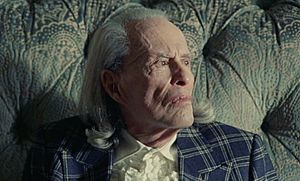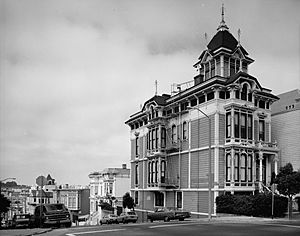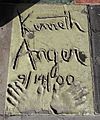Kenneth Anger facts for kids
Quick facts for kids
Kenneth Anger
|
|
|---|---|

Anger in 2019
|
|
| Born |
Kenneth Wilbur Anglemyer
February 3, 1927 Santa Monica, California, U.S.
|
| Died | May 11, 2023 (aged 96) Yucca Valley, California, U.S.
|
| Occupation |
|
| Years active | 1937–2010s |
| Awards | Maya Deren Award (1996) |
Kenneth Anger (born Kenneth Wilbur Anglemyer, February 3, 1927 – May 11, 2023) was an American filmmaker, actor, and author. He was known for making short films, creating almost 40 works starting in 1937. Nine of his films are known as the "Magick Lantern Cycle."
Contents
About Kenneth Anger
Early Life and Interests
Kenneth Wilbur Anglemyer was born in Santa Monica, California, on February 3, 1927. His father, Wilbur Anglemyer, was of German heritage, and his mother, Lillian Coler, had English roots. The family moved to Santa Monica in 1921.
Kenneth was the youngest of three children. His grandmother, Bertha, was a very important person in his life. She helped the family financially and was the first to take Kenneth to the movies. She encouraged his interest in art and film.
Kenneth loved reading movie-related books. He once said, "I was a child prodigy who never got smarter," meaning he felt he learned a lot about film very early on. He even met child star Shirley Temple at a dance event.
In 1935, Anger claimed he acted in the Warner Bros. film A Midsummer Night's Dream. He said he played the Changeling Prince. However, records from the film studio show that a girl named Sheila Brown played that role.
Filmmaking Career
Anger made his first film in 1937 when he was just ten years old. His second film, Who Has Been Rocking My Dreamboat, was made in 1941 when he was 14. It featured children playing and popular songs.
In 1942, he made Prisoner of Mars, a science fiction film where he played the main character. He even built a small volcano in his backyard for special effects! Many of these early films are now lost because Anger later destroyed some of his old work.
In 1944, Anger's family moved to Hollywood. He started attending Beverly Hills High School. There, he met Maxine Peterson, who had been a stand-in for Shirley Temple. He asked her to be in his next film, Escape Episode.
Around this time, Anger also met fellow filmmaker Curtis Harrington. Harrington introduced Anger to the ideas of Aleister Crowley. Crowley's philosophy, called Thelema, greatly influenced Anger's films for the rest of his career.
Anger later studied cinema at the University of Southern California. He also became friends with Dr. Alfred Kinsey. In 1949, Anger began working on a color film called Puce Women.
In 1950, Anger moved to Paris. There, he started filming Rabbit's Moon. He had to stop filming before it was finished, and the footage was stored away. He finally completed and released the film in 1970.
After his mother passed away in 1953, Anger returned to the United States. He reconnected with the art scene in California and became friends with filmmaker Stan Brakhage.
In 1954, Anger created Inauguration, a 38-minute surreal film. It featured themes from Crowley's ideas and included characters representing ancient gods like Isis and Pan. The film won awards at European film festivals.
In 1955, Anger and his friend Alfred Kinsey visited the old Abbey of Thelema in Sicily. This abbey was once used by Aleister Crowley. Anger helped restore some of the wall paintings there. They made a short documentary about the abbey, but it was later lost.
In 1961, Anger began making Scorpio Rising, a film about the biker culture. The film used popular songs from the 1960s as its soundtrack. It quickly became very popular in the underground film scene.
Soon after, Anger's book Hollywood Babylon was officially published in the U.S. It became a big success, selling millions of copies.
In the mid-1960s, the hippie movement was growing. Anger's films became well-known in the underground art world. Many cinemas in the U.S. showed his films together in special events.
In 1966, Anger moved into a large, old Victorian house in San Francisco. He started planning a new film called Lucifer Rising.
In 1981, after ten years of work, Anger finally finished and released the 30-minute film Lucifer Rising.
In 1984, he released Hollywood Babylon II. In 1986, his films were released on VHS, making them available to more people. He also attended a film festival in France that celebrated his work.
In 1991, Anger moved to Palm Springs, California. He lived in a home that used to belong to his friend, actress Ruby Keeler. In 1993, Anger visited Sydney, Australia, and gave talks about his films.

Later Years
In the 2000s, Anger started showing new short films. These included Don't Smoke That Cigarette (2000), which was against smoking, and The Man We Want to Hang (2001), which featured images of Aleister Crowley's paintings. In 2004, he showed Anger Sees Red, a short film starring himself.
Anger's last project was Technicolor Skull with musician Brian Butler. It was a live performance combining light and sound. Anger played the theremin, and Butler played guitar and other electronic instruments.
Kenneth Anger had finished writing Hollywood Babylon III, but it was not published. He passed away on May 11, 2023, at the age of 96.
Film Themes
Kenneth Anger's films often explored certain ideas and images.
One common image in his work is that of flames and light. He used these visuals to create strong feelings in his films.
Music was also very important in many of his films. He used both classical and pop songs to go along with his visuals. He first used music this way in his 1941 film Who Has Been Rocking My Dreamboat?. His use of popular music in films is thought to have influenced the development of music videos and MTV.
Awards
- Maya Deren Award, 1996
- Silver Lake Film Festival Spirit of Silver Lake Award (2000)
- San Francisco International Film Festival Golden Gate Persistence of Vision Award (2001)
- Los Angeles Film Critics Association Douglas Edwards Independent/Experimental Film/Video Award (2002), "for his body of work"
- Anthology Film Archives, Life Achievement Award (2010)
Images for kids
See also
 In Spanish: Kenneth Anger para niños
In Spanish: Kenneth Anger para niños





